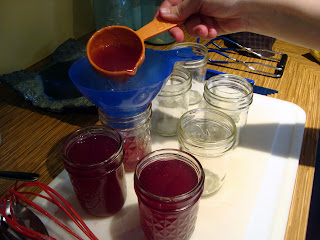Today was the first cool day we have had here in a while, and I had plans for some type of soup. As I rummaged through the pantry to see what was hanging around, I found several russet potatoes crying out to be used, a small piece of cheddar cheese that looked very lonely in the cheese drawer all by itself, and a few strips of bacon from the freezer. That sounded like the beginnings of a pot of potato soup. I am sure everyone is familiar with potato soup, but if you are anything like me, the familiar sometimes gets lost in your mental file box as you try new recipes. So, here is reminder that potato soup is yummy and should not be forgotten. In fact, it should be made as soon as possible!
 |
| Sorry about the terrible picture- this is what happens when you take a quick picture with no daylight and only a small kitchen lamp. Anyway, focus on the soup, not the poor photography. |
This soup is pure comfort food, and is the perfect quick meal following the hustle and bustle of the holidays or on a weeknight when spending hours in the kitchen is just not very appealing. It takes about 30 minutes start to finish, and most of that is hands-off time. It needs no more than the toppings, but it is also delicious with a grilled sandwich or a light salad and bread and butter pickles. It is creamy with small chunks of potato and a deep potato flavor which is enhanced by a sprinkling of cheese and bacon. You can omit the cheese and bacon, but I am warning you that they are what take it from potato soup to potato soup!!! We enjoyed a warm bowl tonight sprinkled with cheese and bacon with sweet pickles on the side. Yum!
This recipe is an adaptation from a Paula Deen recipe I found years ago and have been making ever since. I leave out the shrimp and corn (which the original recipe calls for), and I cut the recipe in half because I don't need to feed an army. I have also adapted it slightly to include a little more liquid as I found that it was a little thick the first time I made it.
The soup is so filling that a single serving usually satisfies, and since it does not keep that well, I only make what I need. If you are serving four or fewer, make my scaled down version (below). If you need to feed 6 to 8 or are feeding very hungry people, you can double the ingredients very easily. This is not low-fat food, so if you are starting a New Year's resolution, you had better make this asap so you don't ruin it. However, made with low-fat milk and only a small bit of half-and-half, it is not as bad as some potato soups out there either.
Loaded Potato Soup
makes approximately 5 one-cup servings
2 tbsp unsalted butter
1/2 onion, minced
1 carrot, peeled and diced
1 tbsp all-purpose flour
1 vegetable bouillon cube, crumbled
4 medium russet potatoes, peeled and diced
2 1/2 cups 2% milk
1/2 cup half-and-half
1/2 tsp kosher salt
1/4 tsp freshly ground black pepper
4 slices bacon, cooked and crumbled
2 oz sharp cheddar cheese, grated
2 scallions, sliced (we don't usually have them, but if you do they are good)
In a 3 quart pot (or larger), melt the butter. Cook the onion and carrot in the butter on medium-low until soft, about 8 minutes. Whisk the flour and crumbled bouillon cube into the onion mixture and cook 1 minute. Slowly whisk in the milk being careful to work out any lumps. Add the potatoes and bring to a slight simmer. Simmer 20 minutes until soft and easily smashed with a fork (be careful not to bring to a rolling boil to prevent the milk from curdling). Add the salt and pepper. Using a potato masher, lightly mash some of the softened potatoes into the soup, leaving some chunks behind. Add the half-and-half and cook 1 minute longer. Ladle soup into bowls and garnish each serving with a sprinkling of cheese, bacon, and scallions (if using).









































